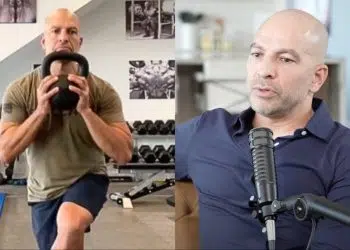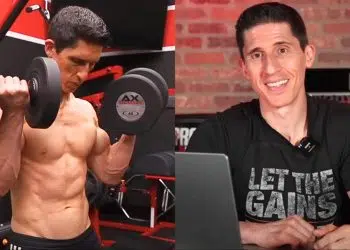Resistance training isn’t only about building muscle—in reality, it improves every aspect of your fitness, including strength, explosive power, cardiovascular endurance, and flexibility. People who lift weights are less prone to fatal diseases (like heart attacks or strokes), more resistant to injuries, and have a longer lifespan with lower mortality rates.
Simply put: it’s the best thing you can do to have a healthy, “fit” body and give yourself many more years of life to enjoy.
If you’re going to get serious about lifting weights and bodybuilding, it’s important that you have a firm foundation of the fundamentals. That means not just knowing what exercises to add into your workout, but how much of each exercise to do.
“Sets” and “Reps” are the two terms you’ll hear thrown around the gym on a daily basis. You’ll need to learn all about them in order to maximize the effectiveness of your workout.
Don’t worry: they’re both simple concepts that are incredibly easy to grasp, and they’ll be the springboard to facilitating your training so you can see real muscle size and strength growth.
Defining “Sets” and “Reps”
You’re going to hear these terms A LOT when it comes to weight training. In fact, they are the foundation upon which all bodybuilding workouts are built. You’ll be glad to know they’re not at all complicated!
Level Up Your Fitness: Join our 💪 strong community in Fitness Volt Newsletter. Get daily inspiration, expert-backed workouts, nutrition tips, the latest in strength sports, and the support you need to reach your goals. Subscribe for free!
Let’s start with “reps”…
“Reps” stands for “repetitions”, or the number of times you’ll repeat an exercise in each “set”. It doesn’t matter what dynamic exercise you do—Crunches, Push-Ups, Deadlifts, or Power Lunges—you’re going to need to count repetitions. Why? Because (as we’ll explain below) the number of repetitions you do will change the way each set affects your muscles.
Moving on…
“Sets” refers to the number of reps you perform consecutively before resting. For example, “a set of 12 reps” means you perform the same exercise (Bench Press, Deadlift, Kettlebell Swing, etc.) 12 times before you can take a rest.
Let’s say your trainer tells you to do “2 sets of 10 reps”. What that means is “perform 10 repetitions, rest for one minute, then perform another 10 repetitions”. Each “set” always ends in a rest period that allows your muscles to recover before moving, either to the next set or the next exercise.
Why Do Sets and Reps Matter?
You may be wondering, “Why break it down like this? Why not just do all the exercises at once and be done with it, rather than working and resting and working and resting?”
The answer to that is actually quite simple: you get the most effective workout when you incorporate rest periods between periods of exertion.
Think about the last time you did something very intense. Perhaps you lifted something very heavy, or you had to run up a long flight of stairs. By the time you finished—or maybe even part of the way through—you could already feel the burn in your muscles, your heart was beating hard, and you were getting tired. You didn’t have much left in the tank, and if you tried to push much longer, your body would give out.
This is the concept of “muscle failure”—put simply, your muscles burn through available energy, build up lactic acid, and are no longer able to contract properly. When this happens, the muscles need time to recover before functioning fully again.
On the macro scale, muscles trained fully to failure need 24-48 hours of recovery time. On a micro scale, after one set with the right number of repetitions (explained below), your muscles need a MINIMUM of 60 seconds (up to 4 or 5 minutes, depending on the training methodology) of recovery time.
Dividing the workout into sets and reps ensures that you can push your body to the maximum safely. You gradually push your muscles to their limit rather than blasting them all at once, so you have more time to work in various exercises that hit the muscles from multiple angles, with enough rest time between that you can work at a significantly higher training volume (also explained below) than you would if you tried to do as many repetitions as you could all at once.
More Sets + Reps = Higher Training Volume
The term “training volume” refers to the amount of weight you lift multiplied by the sets and reps performed.
Let’s say you Bench Press 200 pounds. During your workout, you perform 5 sets of 10 reps each. That’s 50 total reps x 200 pounds—for a total training volume of 10,000 pounds.
Training volume is a metric typically utilized by those looking to increase muscle hypertrophy (defined as “an increase and growth of muscle cells”, or “bigger muscles”.) Science has proven that a higher resistance training volume will enhance muscular size, though it doesn’t lead to massive strength gains.
This is a useful metric for everyone to use to track their performance. Bodybuilders and powerlifters lifting very heavy typically perform fewer reps per set (1-4), but with a higher lifting load (heavier weights). Endurance trainees perform high-rep sets (15-25) with significantly lower weight. Taken all together, the training volume is actually roughly the same.
For example:
- 300 pounds x 3 reps x 5 sets = 4500 pounds of training volume
- 75 pounds x 20 reps x 3 sets = 4500 pounds of training volume
Do you need to measure your training volume? For beginners, training volume is not the most important metric to focus on. It’s a concern more useful for advanced resistance trainees, but for those new to training, the thing to focus on is the right number of reps and sets per muscle/muscle group worked to see the desired results.
The Ideal Rep Range for the Results You Want
By now, you’re probably wondering, “How many reps should I be doing in each set? And how many sets of each exercise should I do?”
Level Up Your Fitness: Join our 💪 strong community in Fitness Volt Newsletter. Get daily inspiration, expert-backed workouts, nutrition tips, the latest in strength sports, and the support you need to reach your goals. Subscribe for free!
Those are two distinct questions, so let’s break them down one at a time.
First, let’s talk about reps. Or, more accurately, “rep ranges”.
The ideal number of reps is a subject of great debate among the fitness and bodybuilding community. Even coaching and training certification programs disagree on exactly how many reps are ideal for building strength, power, and endurance.
What everyone can agree on, however, is the basic principle of training. That principle is:
- More reps with less weight = endurance-focused training.
- Fewer reps with greater weight = power training.
You see, your muscles are actually made up of three different muscle fiber types; Type I, Type IIa, and Type IIb.
Type I muscle fibers are called “slow twitch” muscle fibers because of their slow contraction time. They are more resistant to fatigue, and they’re the basis of your muscular endurance. Typically, they aren’t activated until the energy stored in both Type IIa and IIb muscle fibers are approaching exhaustion. They don’t grow as much, either.
Type IIa and IIb “fast-twitch” muscle fibers account for the bulk of your muscle size. They are larger because they need to store more energy, as they’re the first muscle fibers to be activated. Type IIb muscle fibers activate immediately, while Type IIa activate after the first few repetitions. They provide the most initial strength and power, but will deplete their energy reserves quickly.
Understanding this, we can move on to talking about the ideal rep range to work in order to build power, strength, stamina, and endurance.
When we talk about power, we’re typically talking about the ability to lift a significant amount of weight. Think about the bodybuilders who squat or deadlift 700-1000 pounds. Their muscles are capable of generating significant amounts of raw power, but as you no doubt guessed, the high power generation burns through energy stores incredibly quickly.
Power-focused training typically works in VERY low rep ranges—usually a minimum of 1 rep (for 1-Rep Max weight) and a maximum of 4 reps—but with the heaviest weight your muscles can handle. With this rep range, the Type IIb fast twitch muscle fibers do the majority of the work.
Moving on to the strength and stamina rep range. This is sort of the “middle ground”—your muscles generate a lot of power, but it’s not immediately exhausted. Instead, you have the capacity to perform more repetitions, because your Type IIa fast twitch muscle fibers are providing backup to the Type IIb muscle fibers, lending their energy to ensure that you can keep lifting for more repetitions.
Strength and stamina-focused training typically works in a medium rep range—usually a minimum of 6 repetitions, and a maximum of 12 repetitions—with weight that is heavy but not maxed out. The weight range will often be in the 65-85% of 1-Rep Max. The higher the weight, the fewer the number of reps, and the lower the weight, the greater the number of reps.
Endurance is the capacity to generate power for a sustained amount of time. Strength and stamina are both required, but eventually, the higher number of repetition burns through all the energy stored in your Type II fast-twitch muscle fibers and the Type I slow-twitch muscle fibers are called upon to keep you going.
Endurance-focused training typically works in a high rep range—usually a minimum of 15 reps, but with no maximum. LITERALLY! Some training methodologies work toward performing hundreds of repetitions (Squats, Push-Ups, Burpees, Box Jumps, etc.) without pausing. However, for resistance training, according to the recommendations of the National Federation of Professional Trainers, there’s a maximum of 25 repetitions in a single set.
The weight used is also significantly lighter (between 45 and 65% of the 1-Rep Max weight). This is necessary because the higher rep range will burn through the large quantities of energy available in your fast-twitch muscle fibers, and your slow-twitch muscle fibers have only limited energy—which, thankfully, they burn through much more slowly.
To recap the “rep ranges”:
- Power training works in the 1-4 rep range
- Strength/stamina training and muscle-building training works in the 6-12 rep range
- Endurance training works in the 15-25 rep range
Now that we’ve figured out how many reps you need to do per set, it’s time to talk about set numbers.
This is another subject of great debate among trainers and fitness programs. Most will agree that 3-5 sets PER EXERCISE is ideal.
For example, if you’re doing Bench Presses, you do 3-5 sets of Flat Bench Press, 3-5 sets of Decline Bench Press, 3-5 sets of Incline Bench Press, and so on.
Working in this 3-5 set range enables you to work the target muscle/muscle group to fatigue.
As for how many sets to do per muscle/muscle group, there is a pretty simple rule of thumb to follow:
The larger the muscle/muscle group, the more sets are required.
How does this translate into real life?
- Your chest, upper back, and legs should get the most sets per workout—between 8 and 15 total.
- Your biceps, triceps, shoulders, calves, lower back, abs, and obliques can settle for fewer total sets per workout—between 5 and 10 are ideal.
The larger muscles/muscle groups can store more energy, so they require more exercise to fully train to fatigue than the smaller muscles/muscle groups. Some muscles also have more “muscle heads” than others–for example, your quadriceps (leg) muscles have four heads, your deltoids (shoulders) have three, but your biceps have just two. Muscles/muscle groups with more heads require more volume and/or angles to maximize growth across all the heads.
Working within a higher set range also allows you to incorporate enough variety into the workout that your body is always challenged in new ways. while still delivering focused training for each muscle and muscle group. This is absolutely imperative for seeing real, long-term improvement—without variety, your body adapts to the exercises, leading to plateaus in both strength and muscle growth.
Wrapping It Up
Understanding these workout basics we’ve explored above can help you structure your workout program for maximum effectiveness based not only on the muscles you’re working, but also your ultimate goal. Whether you’re training for power, strength, stamina, or endurance, there is an “ideal” rep range and number of sets to work with in order to see real progress.














